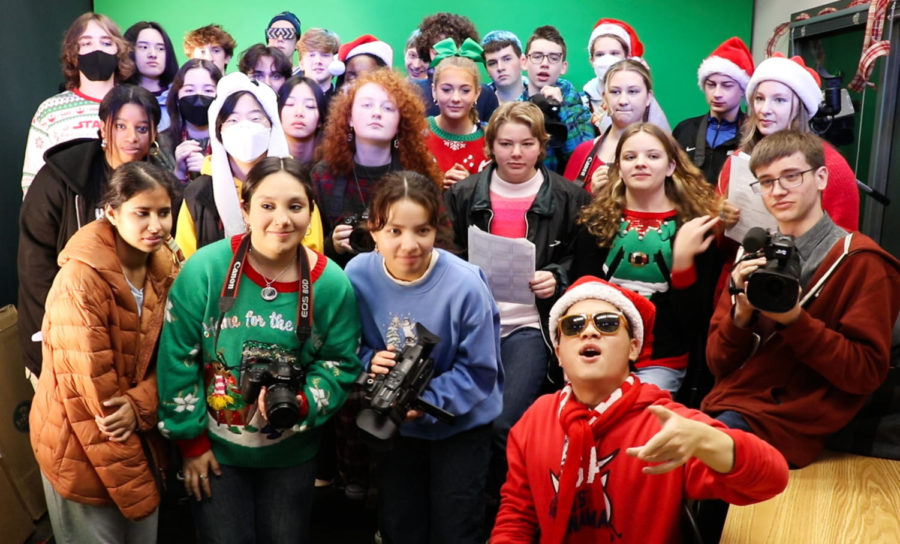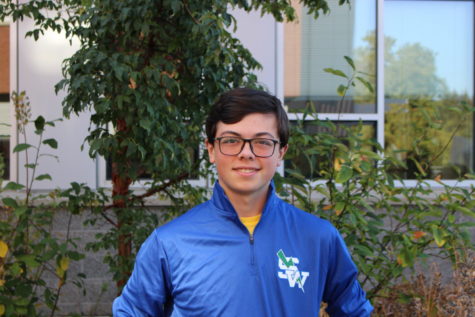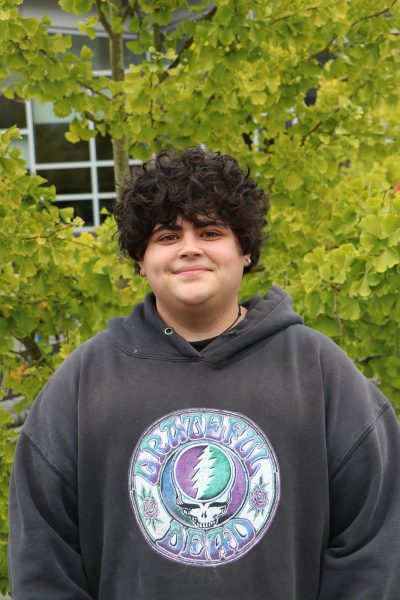Taking to the SEA…TV
New year, new name, new look!
The SEA-TV works on new projects constantly, most recently their annual holiday video. (Photo courtesy of Marty Ballew)
January 31, 2023
You’ve likely never thought of ‘the news’ as being fun. Maybe it’s something your older relatives read in order to stay informed. Sure, it has information, but where’s the fun in that? Maybe you looked through a paper once and were disappointed at the lack of Sudoku or a Crossword. Shorewood is no exception, and in its time, has also produced its fair share of mediocre and boring news.
The News and Events for Students and Teachers crew, otherwise known as the NEST, was a weekly video announcement produced by the Film Production Club for the Shorewood Thunderbirds. The club produced weekly content during SAS informing the student body of news and events in the school. It was a lot like other news sources. Informative, sure, but it lacked that fun and energetic spin that engaged the young people in their target audience. That was, until something big happened in the 2021-22 school year.
Marty Ballew, advisor and executive producer to the club, touched on this change, which had been looming in the minds of the club for a while. “[The Video Bulletins] had become The NEST.” Ballew noted, referring to the name’s origin when the school was rebuilt nearly ten years ago. “But then, of course, [Shorewood] changed our mascot, so that wasn’t going to work anymore.” The Thunderbird was out, and in its place, a Stormray bringing change to the school. “It was ridiculous how much time we spent last year trying to figure out what we were going to call ourselves. There were a bunch of ideas we were throwing around, but it wasn’t until the end of the school year, a student came to me and was like: ‘SEA-TV. Student Events and Activities television.’ – So SEA-TV was born.”
If the club was going to rebrand itself, Ballew decided it was also high time they re-evaluate their standard of content. “We wanted to take the opportunity to hit the reset button and just kind of smooth out the rough edges of our productions and get a little more organized. I also kind of decided to ramp up my expectations of students this year.” Ballew asserted. “Last year, I had a lot of students on the NEST crew, but only about a third of them were really dedicated and consistently creating content.” Ballew wanted a higher level of engagement, and to get there, something had to change.
“‘I’m just gonna come up with teams this year,’” Ballew noted, remarking on his idea. “So I decided to just come up with teams this year, and they’re kind of competing against each other in a way, just a bit of friendly competition-which team can create the best content consistently-and that spirit of competition has definitely helped to elevate the production value.”
This fresh and competitive environment brings a fun atmosphere to the group, and members of the club are always eager to do their part. “I spend a lot of time [on SEA-TV]. Students are always coming in during lunch to work on content,” Ballew noted. “It is a big time investment.” With SEA-TV releasing episodes weekly, it’s no doubt a lot of time and effort on the part of the crew, but without being in the club, it’s hard to understand just what they’re putting into this. “Usually, the industry standard is that every minute of completed video production takes about an hour of time; of man -people- hours to achieve. So on average, usually, our videos are anywhere from five to eight minutes every week.” Ballew chuckled as he said this. “That’s about right.”
With five to eight hours a week typically being spent on the video bulletin, it’s a wonder what all that time is spent on. “First is accepting video bulletin requests that people need for a club or an event. Every week that a team is on rotation -every team takes one week, there’s 4 teams and they rotate- every fourth week, they are responsible for creating one video bulletin. Whichever team volunteers for that video bulletin request will produce it and edit it, and then they have to write the idea -it all begins with the writing- then the execution, the production, filming, and then the post production, which is the editing and the polishing of the final product.” Ballew listed out the order in which each weekly bulletin is made. “There are about 40 people [on SEA-TV], so on that monthly schedule, about eight to ten people a week are running the show.” He added.
That’s a lot of the ‘behind the scenes’. But what about the stuff we do see? “We have the SEA-TV anchors write the scripts,” Ballew remarked. “A lot of times, video bulletins are like: ‘here’s the time and here’s the place’, so they do some writing there, and put in their creative input. Their job is to make it a little more conversational, and not so rigid.” A difficult job, but one the anchors pull off flawlessly.
With the scripts written, filming can begin. “We film in the control room in the studio, which is when the anchors are actually being filmed, and that’s all live-to-tape.” In other words, it’s all one take. They keep the mistakes and the giggles. Everything. Looking at previous broadcasts, it might be hard to tell, but that’s all due to the incredible job done by the anchors.
When production is finished, and the editing complete, an episode is released, for the enjoyment of the student body, and the satisfaction of those who created it. However, entertainment and information aren’t all that SEA-TV brings to Shorewood. “Tons of student leadership,” Ballew noted, is also brought to those involved in SEA-TV.
While the club brings many great things to our school, what’s most important, Ballew claims, is that they have a lot of fun creating and working together. “Always, my favorite time of the school day is my SAS class. We just create stuff, and it’s just amazing to see students collaborating in a way that isn’t part of an academic curriculum,” Ballew said.




